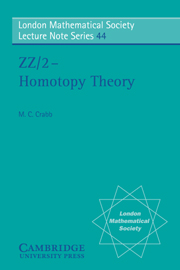Book contents
- Frontmatter
- Contents
- Acknowledgments
- 1 Introduction
- 2 The Euler class and obstruction theory
- 3 Spherical fibrations
- 4 Stable cohomotopy
- 5 Framed manifolds
- A Appendix: On the Hopf invariant
- 6 K-theory
- 7 The image of J
- 8 The Euler characteristic
- 9 Topological Hermitian K-theory
- 10 Algebraic Hermitian K-theory
- B Appendix: On the Hermitian J-homomorphism
- Bibliography
- Index
- Frontmatter
- Contents
- Acknowledgments
- 1 Introduction
- 2 The Euler class and obstruction theory
- 3 Spherical fibrations
- 4 Stable cohomotopy
- 5 Framed manifolds
- A Appendix: On the Hopf invariant
- 6 K-theory
- 7 The image of J
- 8 The Euler characteristic
- 9 Topological Hermitian K-theory
- 10 Algebraic Hermitian K-theory
- B Appendix: On the Hermitian J-homomorphism
- Bibliography
- Index
Summary
The cyclic group, ℤ/2, of order two plays a leading rôle in the theory of real vector bundles and manifolds. More precisely, it plays many parts, as abstract permutation group, as orthogonal group in dimension one, as Galois group of ℂ over ℝ, now clearly distinguished, now merging one into another. The plot is not, by any means, fully revealed. We recount here but a few scenes in which ℤ/2 figures.
The results largely occur in some form in the literature, many in the unpublished thesis [25]. Our purpose here is to present a concise account from the particular viewpoint of ℤ/2-homotopy theory and without detailed proofs.
We begin with an extremely simple, but fundamental, result; as we shall see in §3, it lies very close to the theorem of Kahn and Priddy. Here and throughout the essay L will denote the real representation ℝ of ℤ/2 with the non-trivial action as multiplication by ±1.
Proposition (1.1). Let ξ and ξ' be real vector bundles over a compact ENR X. Suppose that the sphere-bundles S(ξ) and S(ξ') are stably fibre-homotopy equivalent. Then S(L⊗ξ) and S(L⊗ξ') are ℤ/2-equivariantly stably fibre-homotopy equivalent.
Notation. Any space may be considered as a ℤ/2-space with the trivial action. We use the same symbol for the original space and the corresponding ℤ/2-space. Thus, S(ξ) as ℤ/2-space is the sphere-bundle with the trivial involution; S(L⊗ξ) is the same space, but endowed with the antipodal action of ℤ/2.
- Type
- Chapter
- Information
- ZZ/2 - Homotopy Theory , pp. 1 - 4Publisher: Cambridge University PressPrint publication year: 1980



